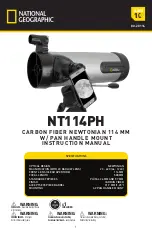
ENGLISH
I
17
Deep sky objects are simply those objects outside the boundaries of our solar system They include star clusters,
planetary nebulae, diffuse nebulae, double stars and other galaxies outside our own Milky Way Most deep sky objects
have a large angular size Therefore, low-to-moderate power is all you need to see them Visually, they are too faint to
reveal any of the color seen in long exposure photographs Instead, they appear black and white And, because of their
low surface brightness, they should be observed from a dark sky location Light pollution around large urban areas
washes out most nebulae making them difficult, if not impossible, to observe Light Pollution Reduction filters help reduce
the background sky brightness, thus increasing contrast
OBSERVING DEEP SKY OBJECTS
Viewing conditions affect what you can see through your telescope during an observing session Conditions include
transparency, sky illumination, and seeing Understanding viewing conditions and the effect they have on observing will
help you get the most out of your telescope
SEEING CONDITIONS
Transparency is the clarity of the atmosphere which is affected by clouds, moisture, and other airborne particles Thick
cumulus clouds are completely opaque while cirrus can be thin, allowing the light from the brightest stars through Hazy
skies absorb more light than clear skies making fainter objects harder to see and reducing contrast on brighter objects
Aerosols ejected into the upper atmosphere from volcanic eruptions also affect transparency Ideal conditions are when
the night sky is inky black
TRANSPARENCY
General sky brightening caused by the Moon, aurorae, natural airglow, and light pollution greatly affect transparency
While not a problem for the brighter stars and planets, bright skies reduce the contrast of extended nebulae making them
difficult, if not impossible, to see To maximize your observing, limit deep sky viewing to moonless nights far from the light
polluted skies found around major urban areas LPR filters enhance deep sky viewing from light polluted areas by blocking
unwanted light while transmitting light from certain deep sky objects You can, on the other hand, observe planets and
stars from light polluted areas or when the Moon is out
SKY ILLUMINATION
Although overlooked by many amateur astronomers, solar observation is both rewarding and fun However, because the Sun
is so bright, special precautions must be taken when observing our star so as not to damage your eyes or your telescope Use
an approved solar filter that covers the entire objective opening Always remove your StarPointer finderscope when viewing the
Sun Never project an image of the Sun through the telescope Tremendous heat build-up may result inside the optical tube
This can damage the telescope and/or any accessories attached to the telescope
Solar Observing Hints
• The best time to observe the Sun is in the early morning or late afternoon when the air is cooler
• To center the Sun without looking into the eyepiece, watch the shadow of the telescope tube until it forms a circular shadow
• To ensure accurate tracking on SLT models, be sure to select solar tracking rate
OBSERVING THE SUN
Содержание 22084
Страница 2: ...2 I ENGLISH ...
Страница 4: ...4 I ENGLISH ...
Страница 24: ......
Страница 25: ...MODE D EMPLOI Modèle 22084 NexStar 5SLT Schmidt Cassegrain Modèle 22088 NexStar 6SLT Schmidt Cassegrain ...
Страница 26: ...2 I FRANÇAIS ...
Страница 28: ...4 I FRANÇAIS ...
Страница 48: ......
Страница 50: ...2 I DEUTSCH ...
Страница 52: ...4 I DEUTSCH ...
Страница 72: ......
Страница 74: ...2 I ESPAÑOL ...
Страница 76: ...4 I ESPAÑOL ...
Страница 96: ......
Страница 98: ...2 I ITALIANO ...
Страница 100: ...4 I ITALIANO ...
Страница 120: ......









































